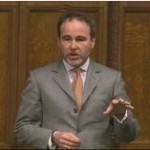Tickets on sale for Quiz Night

 Christopher Pincher, MP for Tamworth, has welcomed proposed improvements to Staffordshire’s local health services which have been promised in a recent report by the National Health Service.
Christopher Pincher, MP for Tamworth, has welcomed proposed improvements to Staffordshire’s local health services which have been promised in a recent report by the National Health Service.
And he has called on the healthcare providers across the county to make sure their commitment to working together for the good of patient care becomes a reality.
NHS England published the Staffordshire Local Health Economy final report on 30th March 2016. The report was commissioned by tri-partite organisations, NHS England, NHS Trust Development Authority, and Monitor, to help the local health system develop its five year strategy plan. The news was circulated by the South East Staffordshire and Seisdon Peninsular Clinical Commissioning Group last week.
The report’s analysis of the health economy has been informed by a locally-led Staffordshire transformation programme, “Together We’re Better” Case for Change. The Report highlights the changes in longevity (there are now 25% more people in Staffordshire over 75 than there were in 2001 and the number is rising) and the challenges of new health problems such as the increase diabetes which is attributed in part to poor eating habits.
It says healthcare must adapt to respond to changes like these. This Report will be subject to public engagement over the next few months, and Mr Pincher has encouraged local people to have their say on public health services during the public engagement process.
Improvements that have already been introduced since the Report include: a new tele-health system in primary care for monitoring conditions such as asthma, hypertension and chronic obstructive pulmonary disease; a primary care atrial fibrillation project aimed at significantly improving detection and incidence of AF-related strokes; and an acute visiting service to provide rapid response for patients requiring a home visit.
Mr Pincher said, “I am delighted to see that the National Health Service in Staffordshire is improving its level of provision, and its accountability to people through the upcoming public engagement process in which I would absolutely encourage local residents to have their say.
VTamworth is a growing town and it is important that its health care needs, and the wishes of local people, are fully understood. Those needs must have the right level of care provided for them, especially as healthcare needs change and treatments change too.
VThat is one of the reasons why I was in Burton at the end of March to talk to the new clinical leadership at the Burton NHS Hospitals Trust. I am pleased that the report suggests the NHS must be highly responsive to local needs and I encourage all local providers including Burton Trust, HEFT, the CCG and local pharmacies to work together to ensure that it is so.”
 First announced by the Chancellor in his Summer Budget last year, the new National Living Wage delivers a key part of the Conservative Government’s plan to move towards a higher wage economy.
First announced by the Chancellor in his Summer Budget last year, the new National Living Wage delivers a key part of the Conservative Government’s plan to move towards a higher wage economy.
In some parts of the country, a fifth of the entire workforce will benefit directly from today’s increase. It will mean a £900 cash increase for a full-time worker on the current National Minimum Wage and by 2020, 2.9 million workers are expected to benefit directly. The Office for Budget Responsibility (OBR) estimating that in total, up to 6 million people could see a pay rise as a result of a ripple effect causing pay to rise further up the earnings distribution.
To coincide with the day the National Living Wage comes into effect, new analysis launched by the Chancellor today (1 April 2016), also demonstrates that the measure will provide a particular boost for women across Britain. It shows that the new National Living Wage is expected to eradicate the gender pay gap for the lowest paid by 2020. This analysis demonstrates how the National Living Wage will move Britain an important step closer to achieving the government’s ambition to end the gender pay gap for all working people within a generation.
From today, the National Living Wage will give around 900,000 women and half a million men an immediate pay rise in their hourly earnings. By 2020, this translates to 1.9 million women and 1 million men directly seeing a rise in their pay. The gender pay gap at the 10th percentile of the earnings distribution – including those working part-time – is expected to fall from 5.6% currently to zero by the end of the decade. Over the next five years women earning the National Living Wage will see their pay rise by over a quarter and growing more than 1.5 times faster than the salary of an average worker.
This builds on the government’s efforts to back women at every stage of their lives, where significant progress has already been made. More women in work than ever before as well as the lowest gender pay gap since records began.
The government has also committed to providing 30 hours of free childcare a week for working families with 3 and 4 year old children, extended the right to request flexible working to all employees, and introduced a new system of flexible parental leave. It has also moved to ensure employers do the right thing by insisting that all large employers publish their gender pay gap.
The Chancellor said, “I said last year when I announced plans for the National Living Wage that Britain deserved a pay rise. Today, I’m proud to say Britain is getting one.
“So I’m delighted that 1.3 million people across Britain will benefit from the biggest wage increase in eight years thanks to the new National Living Wage.
“The National Living Wage will play a central role in moving Britain to a higher wage, lower tax, and lower welfare economy. It will also mark the end of the gender pay gap for some of our lowest paid and hardest working people.”
 According to new independent figures released today (30 March 2016), there are now 764,000 fewer workless households in this country compared to 5 years ago, a fall of 20%.
According to new independent figures released today (30 March 2016), there are now 764,000 fewer workless households in this country compared to 5 years ago, a fall of 20%.
The figures also show there are 449,000 fewer children living in workless households. And the number of households where no one has ever worked is down by 36,000, a fall of 10% since 2010.
Work and Pensions Secretary Stephen Crabb MP said, “Our economic and welfare reforms are helping to turn around the lives of hundreds of thousands of families up and down the country who were previously overlooked.
“Reforms this government has put in place such as Universal Credit, the Claimant Commitment and the benefit cap and are paying off, supporting a record 31 million people in work, with the unemployment rate also at a 10-year low.
“There are now nearly half a million fewer children living in households where no one works; where they can see one or both their parents benefiting from the dignity of a job and the security that a pay cheque brings.”
Employment figures published earlier this month showed that there are 2.37 million more people in work now compared with 2010 – an average increase of more than 1,000 people in work every single day.
The number of people claiming unemployment related benefits has also fallen to its lowest level since 1975, and there are now around 770,000 vacancies available in the economy at any one time.
The government’s welfare reforms are returning fairness to the benefit system and encouraging people who are able to work to do just that. They include:
Read the working and workless household figures from the Office for National Statistics.
 Nearly 50,000 households have now taken up their Right to Buy since the scheme was reinvigorated in 2012.
Nearly 50,000 households have now taken up their Right to Buy since the scheme was reinvigorated in 2012.
This means 291,000 households have now been helped to purchase a home through Government backed schemes – which also include Help to Buy – since 2010.
The latest figures show more than 3,000 people bought under the Right to Buy scheme between October and December. And councils received £259 million from sales of homes which will go towards building additional homes.
For every additional home sold under the Right to Buy a new additional affordable home is built which further increases the housing stock nationwide. There have now been nearly 5,000 starts on additional homes, exceeding the target for one for one additional sales.
Housing Minister Brandon Lewis MP said, “We are determined that anyone who aspires to own their own home should have the opportunity to do so. These figures show people are still very keen to take up their Right to Buy and why we are now extending that opportunity to housing association tenants.
“Britain is building again and homes are being delivered following the sale of properties. Alongside this a thousand tenants are registering each week to join those who have already realised their dream to own their home.”
Today’s figures show that the top 10 places taking up Right to Buy are Birmingham, Nottingham, Leeds, Sheffield, London’s Newham, London’s Tower Hamlets, Wolverhampton, London’s Southwark, Kingston Upon Hull and London’s Barking.
And the voluntary Right to Buy will extend the discounts currently enjoyed by council tenants to 1.3 million housing association tenants giving them the chance to own their home too.
More than 25,000 housing association tenants have already registered their interest in taking up this option – with 1,000 registering their interest each week.
 Thanks to Staffordshire’s PCC, ten Samsung Galaxy tablets are being made available to ten young people between the age of 12 and 18 who stand out in helping to make their local community safer.
Thanks to Staffordshire’s PCC, ten Samsung Galaxy tablets are being made available to ten young people between the age of 12 and 18 who stand out in helping to make their local community safer.
The tablets were originally provided by one of the major companies bidding to become Strategic Technology Partner for policing in Staffordshire and were used during the procurement process to detail their bid and proposals.
The company Atos indicated they did not want the tablets returned, instead agreeing with the Police and Crime Commissioner for Staffordshire to donate the devices for good causes which reinforce community safety. The tablets have been wiped and returned to the original factory settings.
Matthew Ellis said, “This is a great opportunity to recognise, and reward young people who shine in their efforts to make local communities safer. These top-end tablets haven’t cost the public a penny and it is exceptionally generous of Atos to donate them.
“We’re now looking for nominations of young people from across Staffordshire and Stoke-on-Trent who are between 12-18-years-old and have made their area safer or a better place to live through the actions they have taken. Nominations must be no longer than 100 words and nominations will close on May 31.”
Nominations can be submitted by emailing pcc@staffordshire.pcc.pnn.gov.uk. All nominations by email must have the words “TAB ACTIVE COMPETITION” in the subject heading of the email. Nominations can also be submitted by writing to the Office of the Police and Crime Commissioner, Staffordshire Police HQ (Block 9), Weston Road, Stafford, ST18 0YY. Nominations by post must also state at the top of the nomination “TAB ACTIVE COMPETITION”. Names and contact information must be included in all nominations.
The devices will have the PCC’s Kash Dash and Staffordshire Smart Alert Apps installed, both of which are safety-related.
Commenting on the donations, Atos UK & Ireland Chief Executive Officer Adrian Gregory said, “We are very happy to donate these tablets and delighted that they will be used to support, inspire and provide recognition for young people in Staffordshire.”
 Tamworth’s MP, Christopher Pincher, delivered a speech in the House of Commons last week addressing the extent of the housing challenge in the West Midlands, and the need to work towards a workable solution.
Tamworth’s MP, Christopher Pincher, delivered a speech in the House of Commons last week addressing the extent of the housing challenge in the West Midlands, and the need to work towards a workable solution.
Mr Pincher suggested that by increasing the amount of small to medium enterprises in the development supply chain, construction and development can be increased with greater efficiency.
Mr Pincher said, “88,000 new houses are needed in the west midlands. One of the challenges – even though we have reformed planning, introduced Help to Buy, and are selling public land to private development – is the number of small and medium-sized enterprises in the development supply chain”
Pincher called on the Government to encourage big developers, such as Bovis, Persimmon and Redrow, to franchise some of their land bank to smaller developers. He suggested this would de-risk the big developers, because they would not have to take the risk of building the houses, and help smaller developers, because the planning activity would have been undertaken at minimum cost. He suggested this would ensure more SMEs into the supply chain and help us build “homes for the future in the midlands and beyond.”
Afterwards he said, “We also need a different mix of buildings. I think we need more bungalows mixed into new housing developments so people can downsize in retirement but still stay at the heart of local communities. That also means more larger homes can come onto the market – if older single people have nowhere to downsize to then all they can do is stay living in a home too big for them.”
 Fuel duty will be frozen for the sixth year in a row, Chancellor George Osborne has said.
Fuel duty will be frozen for the sixth year in a row, Chancellor George Osborne has said.
Presenting the 2016 Budget, the Conservative Party elected Chancellor said consumers should be able to benefit from the recent slide in oil prices.
Fuel duty has been held at 57.95p per litre since the March 2011 Budget, when it was cut by a penny.
Fuel duty remains the biggest component of the price of diesel and petrol. Motorists also pay 20% value added tax on those fuels.
As of 14 March, the average price of petrol in the UK was 102.72p a litre and the price of diesel was 102.91p, according to the RAC Foundation.
The duty was last increased in January 2011 from 58.19p to 58.95p a litre.
In the July 2015 summer Budget, Mr Osborne scrapped a planned fuel duty increase for 1 September.
A barrel of Brent crude oil changed hands for $39.52 a barrel on Wednesday, up from prices of below $28 in January, but way below a peak of $115 a barrel in June 2014.
While beer, cider and spirits’ duty will stay unchanged, the duty rates on most wine and higher-strength sparkling cider will increase at the same rate as the Retail Prices Index (RPI) from 21 March. RPI currently stands at 1.3%.
 Tamworth’s MP, Christopher Pincher, has welcomed George Osborne’s 8th Budget delivered this week as “a budget for small business and savers.”
Tamworth’s MP, Christopher Pincher, has welcomed George Osborne’s 8th Budget delivered this week as “a budget for small business and savers.”
He said the measures it contains will help people keep more of their own money to spend as they wish.
Some of the Budget highlights unveiled by the Chancellor include:
Mr Pincher said, “This is a serious Budget for hard-working families, for savers and small businesses. It will help keep our economy on track and ensure we grow faster than any other major economy.
“No wonder Labour’s former Shadow Chancellor has warned his leadership that there is “no magic money tree.” Sadly, Jeremy Corbyn will not listen to him and wants to just spend, spend, spend, the very habit that got us into so much trouble last time under Labour.
“This will be a helpful Budget for Tamworth residents and I look forward to supporting its provisions in the House of Commons. I hope sensible Labour MPs will do the same.”
 The local Conservative Party is seeking people interested in becoming local council candidates for the May 2016 local council elections in Tamworth Borough.
The local Conservative Party is seeking people interested in becoming local council candidates for the May 2016 local council elections in Tamworth Borough.
Local councillors are responsible for local services, such as bin collections, street cleaning, planning decisions, open spaces, play areas, setting council tax, licensing, outdoor events and social housing – alongside many other important local services. Councillors also have a role helping to resolve community issues and providing community leadership.
Being a councillor is a hugely rewarding experience. You get the opportunity to put something back into your community, shaping and changing your area for the better.
The election campaign itself is also a rollercoaster of excitement, something many consider to be a memorable and unique experience.
If you are interested in getting involved and learning how the services in your area are run, putting something back into your local community or you are interested in public service, then this might be an opportunity for you. Most of the meetings councillors attend are in the evening and many councillors have full time jobs as well.
If you are interested in being considered for a candidacy, would like an application form or would like more information, please contact me on 01827 57156 or e-mail office@tamworthconservatives.co.uk.
Local councillors are ordinary people from every walk of life, so this is something anyone can do. We hope you will consider finding out more about becoming a council candidate.